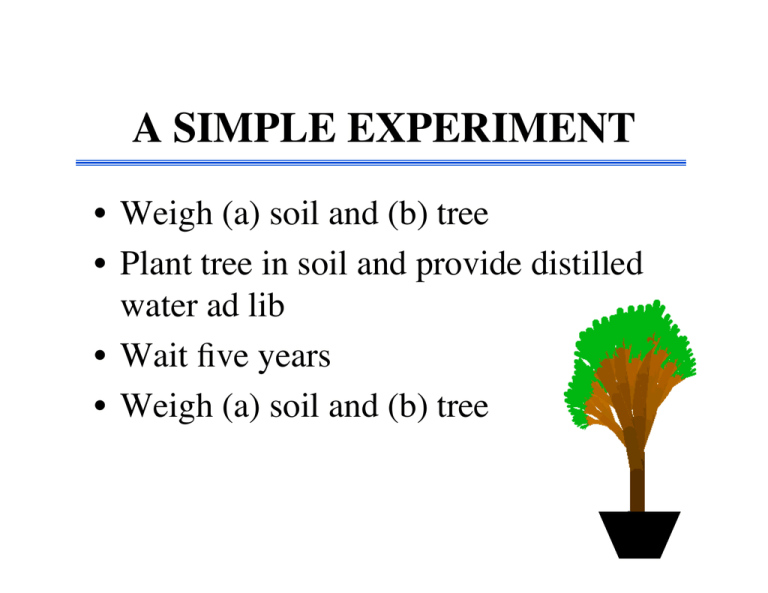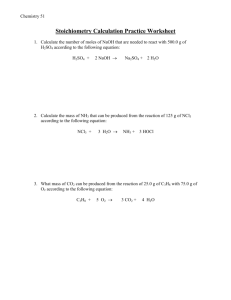
A SIMPLE EXPERIMENT
• Weigh (a) soil and (b) tree
• Plant tree in soil and provide distilled
water ad lib
• Wait five years
• Weigh (a) soil and (b) tree
PLANTS BUILD MOLECULES
• CO2 + H2O + energy CHO + O2
DOES OXYGEN COME FROM
H2O OR CO2 ?
• A SIMPLE EXPERIMENT:
– Label water and feed to plant
– Label CO2 and feed to another plant
– Check each plant’s O2 emission for
label
AND THE RESULT IS:
• Plant given labeled H2O emits O2
THE NATURE OF SUNLIGHT
• …
HOW IS ULTRAVIOLET
LIGHT DANGEROUS?
• It is at a high enough energy state that
it can break biologically meaningful
bonds e.g. DNA
A FACT
• Wavelengths longer than visible light
(i.e. lower frequency) are not at a high
enough energy state to elicit
biologically meaningful reactions (i.e.
heat only)
A CONSTRAINT
• To employ light energy a plant first has
to capture it
PIGMENT
• Def’n - A light-absorbing substance.
PLANTS CONTAIN TWO
CLASSES OF PIGMENT
• Chorophylls
• Carotenoids
(a & b)
FALL COLOURS
• Typical in
temperate habitats
FALL COLOURS FROM
TWO PIGMENTS
• Anthocyanins (red)
• Carotenoids (yellow)
FALL COLOURS: HOW?
• Loss of cholophyll
pigment and production of
anthocyanins
FALL COLOURS: WHY?
• Adaptive explanations:
– Protection against abiotic
factors
– Interactions with animals
ABIOTIC PROTECTION
• Adaptive explanations:
– Photoscreening
– Antioxidants
– Resorption
– Leaf warming
BIOTIC INTERACTIONS
• Adaptive explanations:
– Red is a warning signal to
insect herbivores
– Fruit flag to advertise to birds
• Non-adaptive (for
trees):
- Insects do not prefer red
leaves
A FACT
• To sustain life, plants must transform
light energy into
chemical energy
A FACT
• All photosynthetic events occur within the
chloroplast
ANOTHER FACT
• Light energy is harvested at the thylakoid
membrane and is converted to usable
(chemical) energy in the stroma
MORE PHYSICS
• Photo energy excites electrons i.e.
causes them to move to higher orbitals
A QUESTION AND AN ANSWER:
• Where do positively-charged
photosystems get their electrons from?
• H2O (photolysis)
PRODUCTS OF 1’ST STAGE
LIGHT-DEPENDENT REACTIONS
• Oxygen
• High energy electrons
• Uncharged photosystem
• Protons released into the thylakoid
space
ATP PRODUCTION FROM
PHOTOSYNTHESIS
CARBON FIXATION
• The processing of carbon atoms from
atmospheric gas (CO2) into sugars.
ANOTHER FACT
• Storage products are built by lightindependent reactions in the stroma Calvin cycle YET ANOTHER FACT
• The Calvin cycle produces 3-carbon
sugars
P
Glyceraldehyde 3-phosphate
IT’S TRUE:
• RuBP carboxylase is one of the most
common proteins on this planet PRODUCTS FROM C3
SUGARS
• Glucose - assembled in cytoplasm
• Sucrose - assembled in cytoplasm
• Starch - assembled in chloroplast
A TRADEOFF
• One way to reduce water loss is to close
stomata BUT this procedure also reduces
CO2 availability
From The World Book (TM) Multimedia Encyclopedia (c) 1999 World Book, Inc., 525 W. Monroe, Chicago, IL 60661. All
SOLUTION TO TRADEOFF
• Change pathway - C4
• Change timing of events - CAM
CAM
From The World Book (TM) Multimedia Encyclopedia (c) 1999
World Book, Inc., 525 W. Monroe, Chicago, IL 60661. All rights
C4
From The World Book (TM) Multimedia Encyclopedia
(c) 1999 World Book, Inc., 525 W. Monroe, Chicago,
IL 60661. All rights reserved. World Book
A FACT
• The C4 pathway has independently
evolved in several plant families. This
is a good example of convergent evolution. From The World Book (TM) Multimedia Encyclopedia
(c) 1999 World Book, Inc., 525 W. Monroe, Chicago,
IL 60661. All rights reserved. World Book







